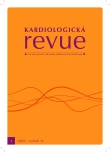Chronological aspects of an acute coronary syndrome
Authors:
J. Sitár 1; J. Střeštík 2
Authors‘ workplace:
Interní a endokrinologická ordinace Polikliniky v Kuřimi
1; Geofyzikální ústav AV ČR, v. v. i., Praha
2
Published in:
Kardiol Rev Int Med 2009, 11(1): 32-34
Overview
Chronological aspects of an acute coronary syndrome. Daily rates of direct PCI interventions in acute myocardial infarctions performed at two cardiology clinics in Brno, Czech Republic, in 2004, 2005 and 2006 were analyzed in order to determine the periods these interventions are more frequent. There was a total of 2195 cases. During a week, two maxima of PCI interventions took place; these were Mondays and Thursdays. Striking minimum of PCI interventions took place during weekends. In the course of a year, a significant peak was observed from February to June and a minimum between July and September. Another maximum took place in October, followed by the second minimum from November to January. Further chronological aspects and particularities in the incidence of an acute coronary syndrome are widely discussed. As seen in our earlier investigations, the frequency of patient admissions to the hospital on Saturday is inversely proportional to the number of sudden cardiovascular deaths out of the hospital,
Keywords:
acute myocardial infarction – weekly variation – annual variation
Sources
1. Sitar J. O týdenním biologickém rytmu v nemocnosti a úmrtnosti na kardiovaskulární nemoci. Cas Lek Cesk 1989; 128: 628–630.
2. Sitar J, Střeštík J. Denní a týdenní variace výskytu infarktu myokardu. Bulletin (XXV. seminář) „Člověk ve svém pozemském a kosmickém prostředí“. Úpice 2004: 160–165.
3. Střeštík J, Predeanu I, Botezat-Antonescu L. Some periodicities in the mortality in Romania 1989–1995. Proceedings of the international conference “Chronobiology and its roots in cosmos“. Stará Lesná 1997: 229–236.
4. Střeštík J, Predeanu I. Některé periodicity v úmrtnosti v Rumunsku v letech 1989–1995. XIII. bioklimatologická konferencia SBkS a ČBkS. Bioklimatológia a životné prostredie. Košice 2000. [http://www.chmi.cz/meteo/CBKS/sbornikKosice/strestik.pdf].
5. Letfus V, Kopecký M, Klimeš J. Sedmidenní perioda ve výskytu onemocnění infarktem myokardu, hospitalizovaných ve Východočeském kraji 1971–1974. Sborník referátů „Slunce ve zdraví a nemoci“. Ostrava: Hvězdárna Valašské Meziříčí 1978: 65–71.
6. Halberg F, Halberg E, Halberg F et al. Circaseptan (about 7-day) and circasemiseptan (about 3.5-day) rhythms and contributions by Ladislav Dérer. 1. General methodological approach and biological aspects. Biológia 1985; 40: 1119–1141.
7. Halberg F, Halberg E, Halberg F et al. Circaseptan (about 7-day) and circasemiseptan (about 3.5-day) rhythms and contributions by Ladislav Dérer. 2. Examples from botany, zoology and medicine. Biológia 1986; 41: 233–252.
Labels
Paediatric cardiology Internal medicine Cardiac surgery CardiologyArticle was published in
Cardiology Review

2009 Issue 1
Most read in this issue
- Ischemia-reperfusion injury following cardiac arrest and protective effects of hypothermia
- Surgical treatment of atrial fibrillation
- Current issues in resynchronization therapy of patients with heart failure
- Do we have sufficient evidence in 2009 to decide whether to implant biventricular pacemaker or cardioverter-defibrillator to cardiac resynchronization therapy patients?
